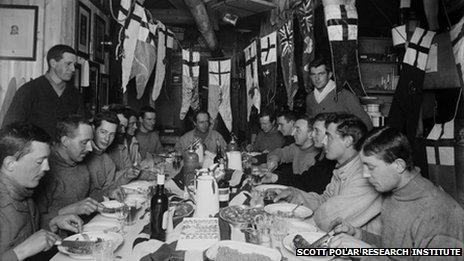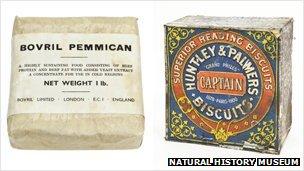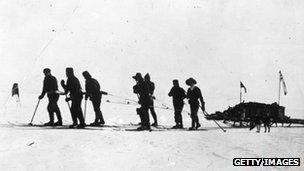Scott's Antarctic diet: Stewed penguin and champagne
- Published

Meals served in the hut at Cape Evans were substantial, and could run to several courses
A century ago Robert Falcon Scott and his men perished on their return from the South Pole. But what did they eat as they explored one of the harshest places on earth - and did their diet contribute to their deaths?
They endured months of freezing temperatures and exhausting sledge-pulling, but life for the men of the Terra Nova expedition was not without comfort, at least not in their wooden hut at Cape Evans.
The smell of fresh bread and rhubarb pie was a common feature of life there.
Seal meat - curried, fried, or in soup - was another constant, and it was popular.
"We never tire of our dish and exclamations can be heard every night," Captain Scott wrote in his diary.

Away from the hut Scott's men took turns to prepare hoosh - a stew made from pemmican and biscuits
They only had what they had brought with them or could catch, and so needed to improvise.
The expedition naturalist Edward Wilson tried cooking with penguin blubber, but the flavour of penguin, "like very bad sardine oil", did not appeal to everyone.
On special occasions, meals ran to several courses. Salted almonds, turtle soup, roast beef, stewed penguin breast in red currant jelly, crystallised ginger, and champagne all featured on such menus.
Sledging rations
Away from the hut it was a different story. The ponies and dog teams had struggled with the conditions - and on their final journey the men had to pull their own sledges.
Georgina Cronin, of the Scott Polar Research Institute in Cambridge, believes "they underestimated the calories needed for man-hauling in Antarctica - this is partly why they suffered so much."
Their rations consisted of pemmican (ground meat mixed with fat), and biscuits baked by one of the expedition's commercial sponsors.
The men took turns to prepare hoosh - a stew made from pemmican and biscuits, with the addition of arrowroot and raisins for variety.
They believed a high level of protein was needed for the exercise they were doing, but nutritionists now know this was not the case.
"Their high-protein diet was probably not good for them," said Dr Mike Stroud, a polar veteran and expert in nutrition.
So what should they have been eating?
"Carbohydrate is needed for blood sugar levels, but you want the most energy for the least weight, so in modern times there has been a move to a high-fat diet," Dr Stroud added.
Rations are now based on cereals, freeze-dried meals, and chocolate bars.
Man-hauling a sledge demands an intake of around 6,000 to 7,000 calories a day, and figures as high as 11,000 have been recorded.
But one foodstuff that has not changed in 100 years of polar exploration is butter.
With twice the calories of the same weight of carbohydrate, butter and other fats can make up 60% of a polar explorer's diet, double the normal recommendation.
"My team mate had chocolate butter to add to meals. Cheese was good, I added cheese to muesli," said Blue Peter's Helen Skelton, who reached the Pole earlier this year.
"You have to eat as much as you can, whenever you can - the advice I was given was to eat before you are hungry and drink before you are thirsty," she added.
Pints of lime
In 1912, getting enough vitamins was difficult for Scott and his men.
It was known that a restricted diet could cause bleeding gums and tooth loss - scurvy.
Scurvy is now understood to be caused by a lack of vitamin C, found in fruit, vegetables, and some meats.
To stave it off, the Terra Nova ship took 1,000 pints of lime juice to Antarctica. Meat from ponies slaughtered en route also helped.
Today, fruit and vegetables are taken to Antarctica by air, but away from base fresh food remains a rarity.
"Oh, to have something fresh - I even dreamt about apples," Helen Skelton wrote in her <link> <caption>blog</caption> <url href="http://www.bbc.co.uk/cbbc/diaries/helen-skeltons-polar-challenge-for-sport-relief" platform="highweb"/> </link> .
Ultimately, Scott and his men did not fully appreciate the nutritional demands they put on themselves.
Ration amounts were based on trial and error and at 4,500 calories a day fell well short of what was needed.

Rations ran out quicker than Captain Scott's men had predicted
Food came to dominate their conversation. Hunger was with them even during sleep.
"They dreamt constantly about food," said Sara Wheeler, polar expert and author.
"Some of them got to eat it, and some woke up just as they were spooning steak and kidney pie into their mouths."
Dr Stroud estimates that on the ill-fated journey to the South Pole the men had a deficit of 3,000 calories a day. That would have meant each man lost 25kg of body weight by the time they got there.
The last minute decision to add a fifth man to a journey originally planned for four put extra pressure on food rations.
"You don't just lose fat, you lose muscle as well. You can't keep warm," said Dr Stroud, who himself experienced starvation when he crossed Antarctica with Sir Ranulph Fiennes in 1992.
"By the time they reached the Ross Ice Shelf, they would have been emaciated."
Vitamin levels - low at the start - would have dropped further.
They had been collecting supplies from depots laid in advance but before they reached one of the last ones, supplies ran out. They died soon after.
So was insufficient food to blame for their fate?
"They didn't make it for a combination of reasons," said Elin Simonsson, a curator at the Natural History Museum in London.
"Unexpected cold, blizzards and sand-like ice slowed them down. Food rations ran out quicker than they could have predicted.
"They had planned according to what they knew, and there is a limit to how much food you can pack on a sledge."
- Published10 March 2012
- Published2 November 2011